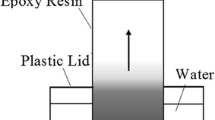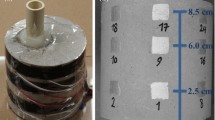Abstract
The time-dependent liquid water distribution in cement mortar mixtures during water absorption was determined using a proton nuclear magnetic resonance imaging (NMRI) technique. The variation of the material water diffusion coefficient with the water content was established on the basis of these results. Eight different mortar mixtures were prepared and tested. Test variables included water/binder ratio (0.60, 0.40 and 0.25), type of cement (an ASTM Type 1 cement and a commercial white cement) and the use of silica fume. In addition, the effect of drying treatments on the water transport properties was also investigated. The absorption of water in dry mortars is found to be well described by a non-linear diffusion equation based on the extended Darcy's law of continuum mechanics. Results also confirm that the macroscopic water diffusion coefficient (D(□)) of mortar is strongly dependent on the material water content. The relationship between the two parameters can be modeled by two exponential equations. Test results finally show that a reduction of the mortar water/binder ratio and the use of silica fume tend to significantly decrease the absorption of water. This phenomenon is well described by the water penetration coefficient λmax.
Résumé
L'évolution de la distribution de la teneur en eau dans divers mélanges de mortier de ciment durant un essai d'absorption capillaire a été étudiée à l'aide d'une technique d'imagerie par résonance magnétique nucléaire du proton. Les résultats ainsi obtenus ont par la suite permis d'évaluer la variation du coefficient de transport de l'humidité en fonction de la teneur en eau de ces différents matériaux. Huit différents mélanges de mortier ont été testés. Les variables étudiées concernaient le rapport eau/liant (0.60, 0.40 et 0.25), le type de ciment (un ciment portland ordinaire de type I selon l'ASTM et un ciment blanc), l'ajout de fumée de silice et le conditionnement des éprouvettes avant l'essai (type de séchage). Les résultats démontrent que le transport de l'eau lors d'un essai d'absorption capillaire peut être décrit par une équation de diffusion non-linéaire. La variation du coefficient de transport de l'humidité peut être modélisée ⦏ l'aide d'une combinaison de deux équations exponentielles. Les données expérimentales indiquent également que la réduction du rapport eau/liant et l'ajout de fumée de silice contribuent à ralentir le transport de l'eau par absorption. Ces phénomènes sont correctement décrits par le coefficient de pénétration de l'eau λmax.
Similar content being viewed by others
References
Galloway, J.W., Harding, H.M. and Raithby, K.D., ‘Effects of moisture changes on flexural and fatigue strength of concrete’. Transport and Road Research Laboratories, Report 864, U.K. (1979) 26 p.
Hanson, J.A., ‘Effect of curing and drying environments on splitting tensile strength of concrete’,ACJ Journal 65 (1968) 535–543.
MacInnis, C. and Beaudoin, J.J., ‘Effect of degree of saturation on the frost resistance of mortars mixes’,ACJ Journal 65 (3) (1968) 203–209.
Nilsson, L.O., ‘Hygroscopic moisture in concrete-drying, measurements and related material properties’, Report TVBM 1003, Lund Institute of Technology, (1980) 162 p.
Tuutti, H., ‘Corrosion of steel in concrete’, Swedish Cement and Concrete Research Institute, Stockhom, Sweden, (1982) 160 p.
Hashiba, H., Tanaka, K. and Koike, M., ‘Moisture distribution in concrete before and after application of the finish’,Building Research and Practice 5 (1990) 303–308.
Parrott, L.J., ‘Factors influencing relative humidity in concrete’,Magazine of Concrete Research 43 (1954) (1991) 45–52.
Bruce, R.R. and Klute, A., ‘The measurement of soil moisture diffusivity’,Soil Science Soc. Am. Proc. 20 (1956) 458–462.
Rose, M., ‘Non intrusive moisture analyser for concrete’, National Science Foundation, Report No. NSF/ISI-88156, Washington, DC, (1989) 85 p.
Pel, L., Ketelaars, A.A.J. and Adan, O.C.G., ‘Determination of moisture diffusivity in porous media using scanning neutron radiography’,Int Journal of Heat and Mass Transfer 36 (5) (1993) 1261–1267.
Justnes, H., Bryhn-Ingegrigtsen, K. and Rosvold, G.O., Neutron radiography: an excellent method of measuring water penetration and moisture distribution in cementitious materials’,Advances in Cement Research 6 (21) (1994).
Quénard, D. and Sallée, H., ‘A. gamma-ray spectrometer for measurement of the water diffusivity of cementitious materials’, Materials Research Society Symposium Proceedings, Vol. 137, (1989) 165–169.
Pel, L. ‘Moisture transport in porous building materials’, Ph.D. Thesis, Eindhoven University of Technology, The Netherlands, (1995) 125 p.
Gummerson, R.J., Hall, C. and Hoff, W.D., ‘Unsaturated water flow within porous materials observed by NMR imaging’,Nature 281 (1979) 56–57.
Carpenter, T.A., Davies, E.S., Hall, C., Hall, L.D., Hoff, W.D. and Wilson, M.A., ‘Capillary water migration in rock: process and material properties examined by NMR imaging’,Mater. Struct. 26 (1993) 286–292.
Hall, C., ‘Water sorptivity of mortars and concretes: a review’,Magazine of Concrete Research 41 (147) (1989) 51–61.
Matsumoto, M., ‘Simultaneous heat and mass transfer in porous wall and analysis of internal condensation’,Int. Seminar Heat and Mass Transfer, Dubrovnik, Vol. 1 (1978) 45–58.
Justness, H., Sellevold, E.J. and Lundevall, G., ‘High strength concrete binders- Part A: Reactivity and composition of cement pastes with and without condensed silica fume’, ACI SP-132, (1992) 873–890.
Kopinga, K. and Pel, L., ‘One-dimensional scanning of moisture in porous materialswith NMR’,Rev. Sci. Instrum. 65 (1994) 3673–3681.
Farrar, T. and Becker, E.D., ‘Pulse and Fourrier Transform NMR. Introduction to theory and methods’, (Academic Press, New York, 1971).
Abragam, A., ‘Principles of nuclear magnetism’, Oxford University Press, New York, USA, 1985).
Gummerson, R.J., Hall, C. and Hoff, W.D., ‘Capillary water transport in masonry structures: building construction application of Darcy's law’,Construction Papers 1 (1980) 17–27.
Bear, J. and Bachmat, Y., ‘Introduction to modeling of transport phenomena in porous media’, Vol. 4, (Kluwer, Dordrecht, The Netherlands, 1990).
Philip, J. R. and Knight, J.H., ‘On solving the unsaturated flow equation: 3. New quasi-analytical technique’,Soil Science 93 (1974) 405–412.
Parlange, J.-Y., ‘Theory of water-movement in soils: 1. One dimensional absorption’,Soil Science 111 (1971) 134–137.
Philip, J.R., ‘Numerical solution of equations of the diffusion type with diffusivity concentration-dependent’,Trans. Faraday Soc. 51 (1955) 885–892.
Gardner, W. and Mayhugh, M., ‘Solutions and test of the diffusion equation for the movement of water in soil’,Soil Science Soc. Amer. Proc. 22 (1958) 197–201.
Martys, N.S., ‘Diffusion in partially saturated porous materials’,Mater. Struct. 32 (1999) 555–562.
Hall, C., ‘Barrier performance of concrete A review of fluid transport theory’,Mater. Struct. 27 (169) (1994) 291–306.
Kohonen, R., ‘A method to analyze the transient hygrothermal behaviour of building materials and components’, Dissertation, Publication 21 Technical Research Centre of Finland, Espoo, 1984.
CIB, ‘Quantities symbols and units for the description of heat and moisture transfer in buildings; conversion factors’, Report No. 37, Rotterdam, 1977.
The NAG Numerical Fortran Library, Mark 15, NAG Ltd, Wilkinson House, Jordan Hill Road, Oxford, U.K., 1991.
Bager, D.H. and Sellevold, E.J., ‘Ice formation in hardened cement paste—Part II: Drying and resaturation of room temperature cured paste’,Cement and Concrete Research 16 (6) (1986) 835–844.
Feldman, R.F., ‘Diffusion measurements in cement paste by water replacement using propan-2-ol’,Cement and Concrete Research 17 (4) (1987) 602–612.
Parrot, L.J., ‘Effect of drying history upon the exchange of pore water with methanol and upon subsequent sorption behaviour in hydrated alite paste”,Cement and Concrete Research 11 (1981) 651–658.
Author information
Authors and Affiliations
Additional information
Editorial Note Loval University (Canada) is a RILEM Titular Member. Prof. J. Marchand was awarded the 2000 Robert L'Hermite Medal. He is Editor in Chief for Concrete Science and Engineering and Associate Editor for Materials and Structures. He participates in RILEM TC 186-ISA ‘Internal Sulfate attacle’.
Rights and permissions
About this article
Cite this article
Hazrati, K., Pel, L., Marchand, J. et al. Determination of isothermal unsaturated capillary flow in high performance cement mortars by NMR imaging. Mat. Struct. 35, 614–622 (2002). https://doi.org/10.1007/BF02480354
Issue Date:
DOI: https://doi.org/10.1007/BF02480354




